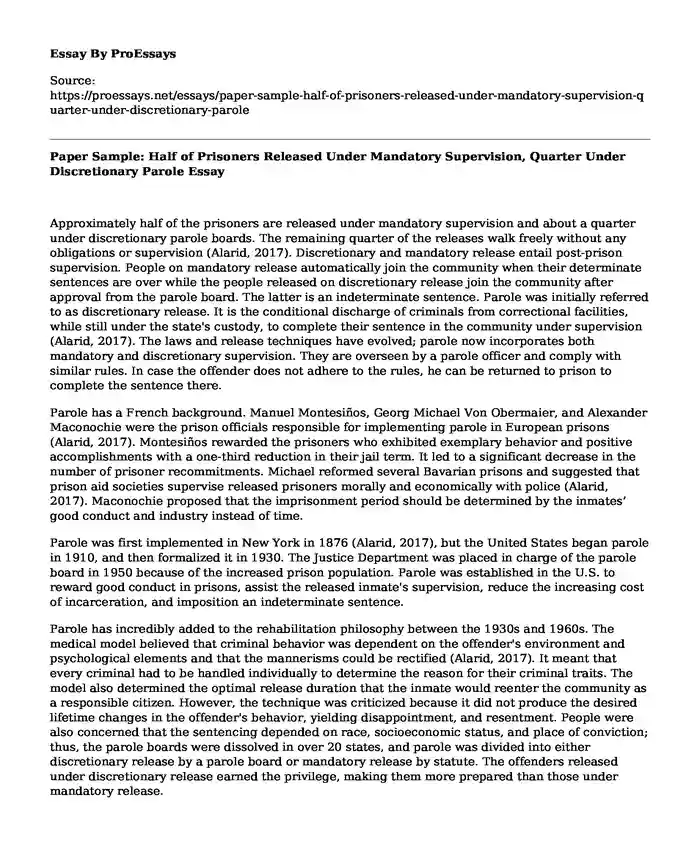Approximately half of the prisoners are released under mandatory supervision and about a quarter under discretionary parole boards. The remaining quarter of the releases walk freely without any obligations or supervision (Alarid, 2017). Discretionary and mandatory release entail post-prison supervision. People on mandatory release automatically join the community when their determinate sentences are over while the people released on discretionary release join the community after approval from the parole board. The latter is an indeterminate sentence. Parole was initially referred to as discretionary release. It is the conditional discharge of criminals from correctional facilities, while still under the state's custody, to complete their sentence in the community under supervision (Alarid, 2017). The laws and release techniques have evolved; parole now incorporates both mandatory and discretionary supervision. They are overseen by a parole officer and comply with similar rules. In case the offender does not adhere to the rules, he can be returned to prison to complete the sentence there.
Parole has a French background. Manuel Montesiños, Georg Michael Von Obermaier, and Alexander Maconochie were the prison officials responsible for implementing parole in European prisons (Alarid, 2017). Montesiños rewarded the prisoners who exhibited exemplary behavior and positive accomplishments with a one-third reduction in their jail term. It led to a significant decrease in the number of prisoner recommitments. Michael reformed several Bavarian prisons and suggested that prison aid societies supervise released prisoners morally and economically with police (Alarid, 2017). Maconochie proposed that the imprisonment period should be determined by the inmates’ good conduct and industry instead of time.
Parole was first implemented in New York in 1876 (Alarid, 2017), but the United States began parole in 1910, and then formalized it in 1930. The Justice Department was placed in charge of the parole board in 1950 because of the increased prison population. Parole was established in the U.S. to reward good conduct in prisons, assist the released inmate's supervision, reduce the increasing cost of incarceration, and imposition an indeterminate sentence.
Parole has incredibly added to the rehabilitation philosophy between the 1930s and 1960s. The medical model believed that criminal behavior was dependent on the offender's environment and psychological elements and that the mannerisms could be rectified (Alarid, 2017). It meant that every criminal had to be handled individually to determine the reason for their criminal traits. The model also determined the optimal release duration that the inmate would reenter the community as a responsible citizen. However, the technique was criticized because it did not produce the desired lifetime changes in the offender's behavior, yielding disappointment, and resentment. People were also concerned that the sentencing depended on race, socioeconomic status, and place of conviction; thus, the parole boards were dissolved in over 20 states, and parole was divided into either discretionary release by a parole board or mandatory release by statute. The offenders released under discretionary release earned the privilege, making them more prepared than those under mandatory release.
In the present date, almost half of the U.S. states exercise both indeterminate and determinate sentencing depending on the type of crime. One-third of the states have a determinate sentencing structure while a quarter of the states have maintained full parole board discretion and an indeterminate sentencing structure. The characteristics of individuals released on parole vary depending on the region. The contemporary function of parole is to correct people who have engaged in non-violent criminal offenses. It facilitates the reintegration of ex-offenders to the community.
References
Alarid, L. F. (2017). Community–Based Corrections, Eleventh Edition. Cengage Learning.
Cite this page
Paper Sample: Half of Prisoners Released Under Mandatory Supervision, Quarter Under Discretionary Parole. (2023, Dec 02). Retrieved from https://proessays.net/essays/paper-sample-half-of-prisoners-released-under-mandatory-supervision-quarter-under-discretionary-parole
If you are the original author of this essay and no longer wish to have it published on the ProEssays website, please click below to request its removal:
- Essay Example: Identity Theft as a Form of Cyber Crime
- Essay on Dulce Pinzon: The Real Story of the Superheroes
- Is Torture Right or Wrong? - Paper Example
- The Stories on the Jerry Sandusky Arrest Essay
- Harlem: Thriving in Literature, Music, and Art - Essay Sample
- Video Games: An Unfortunate Misunderstanding - Essay Sample
- Hate Crime Laws Paper Example







